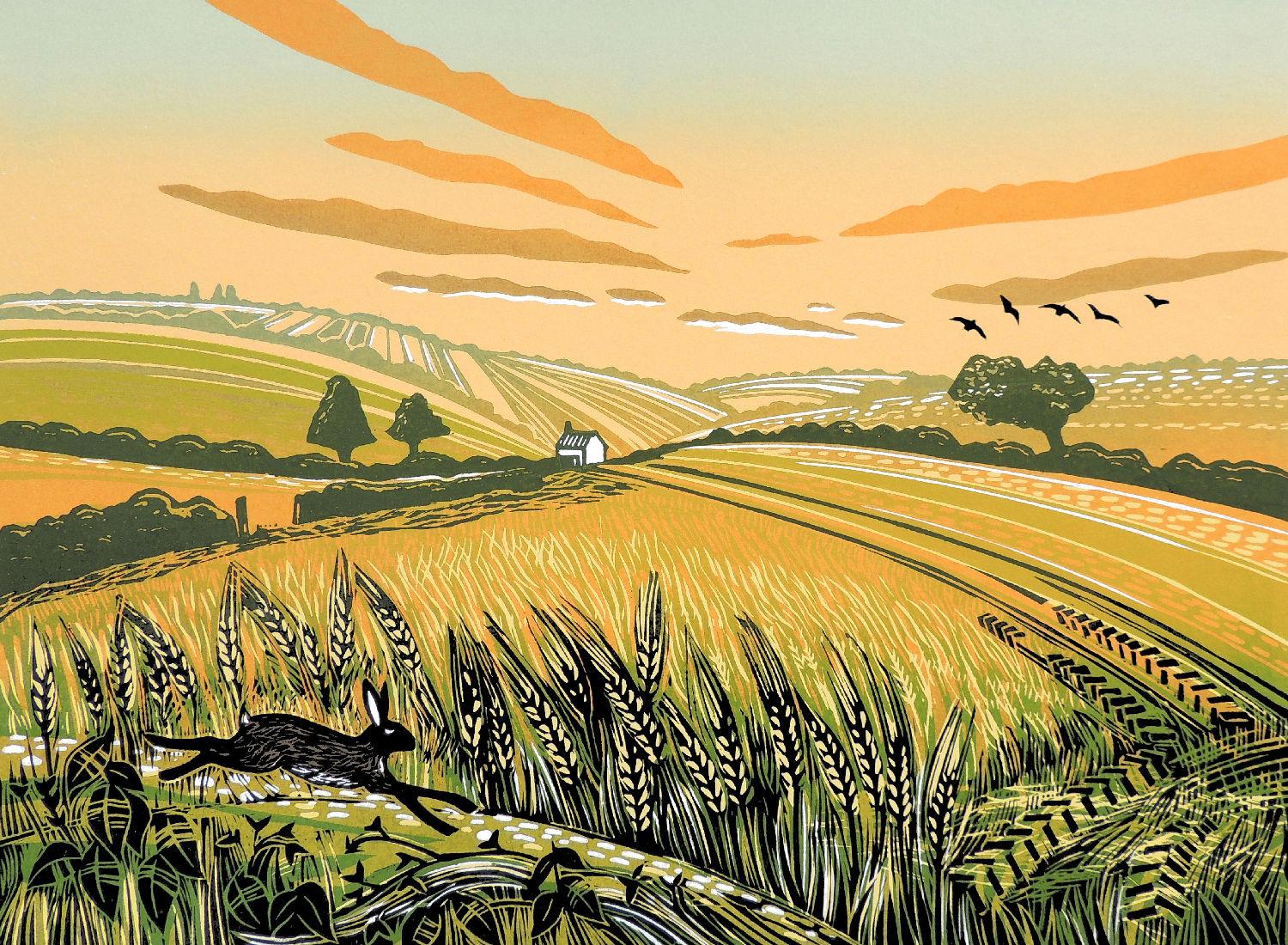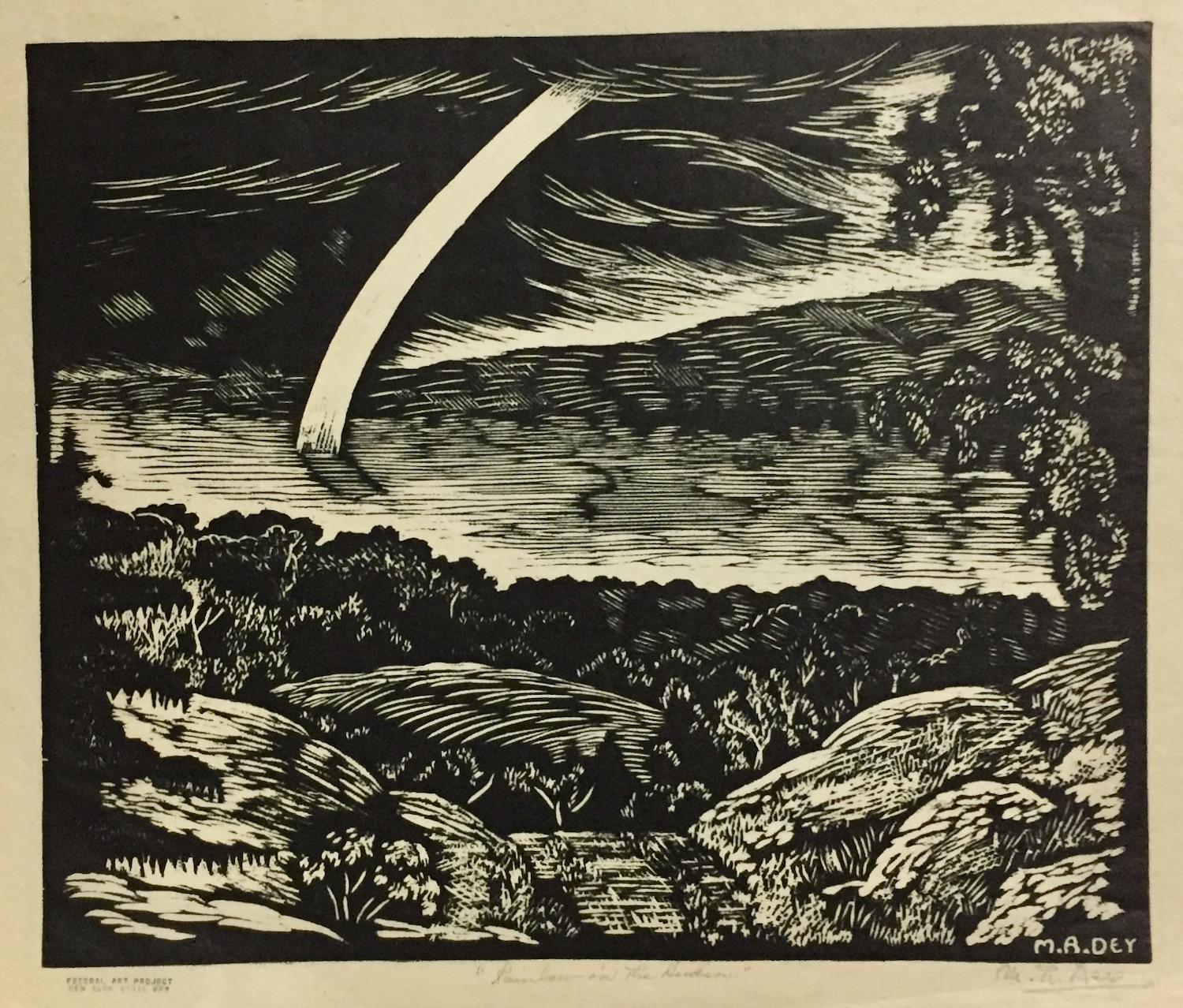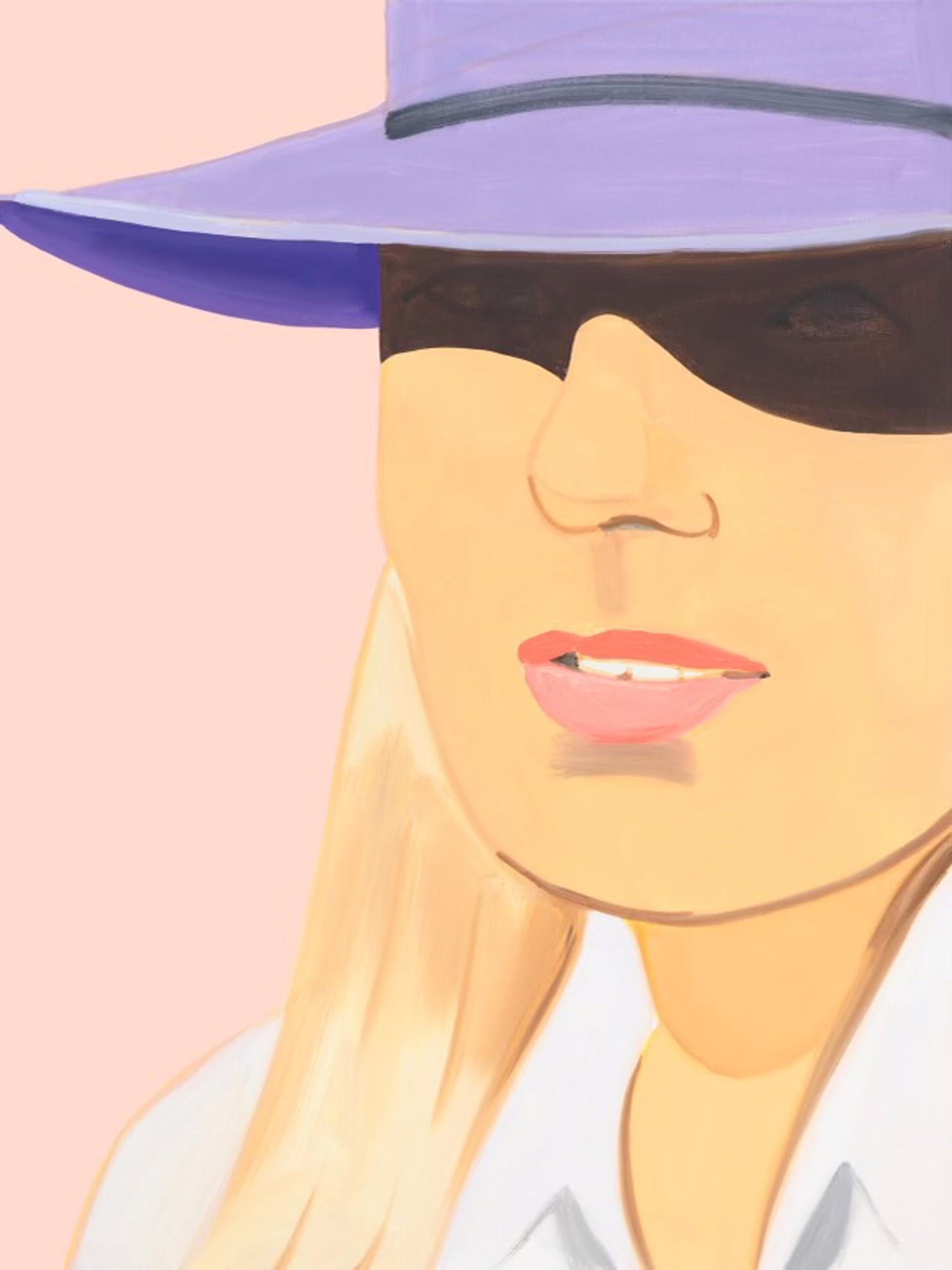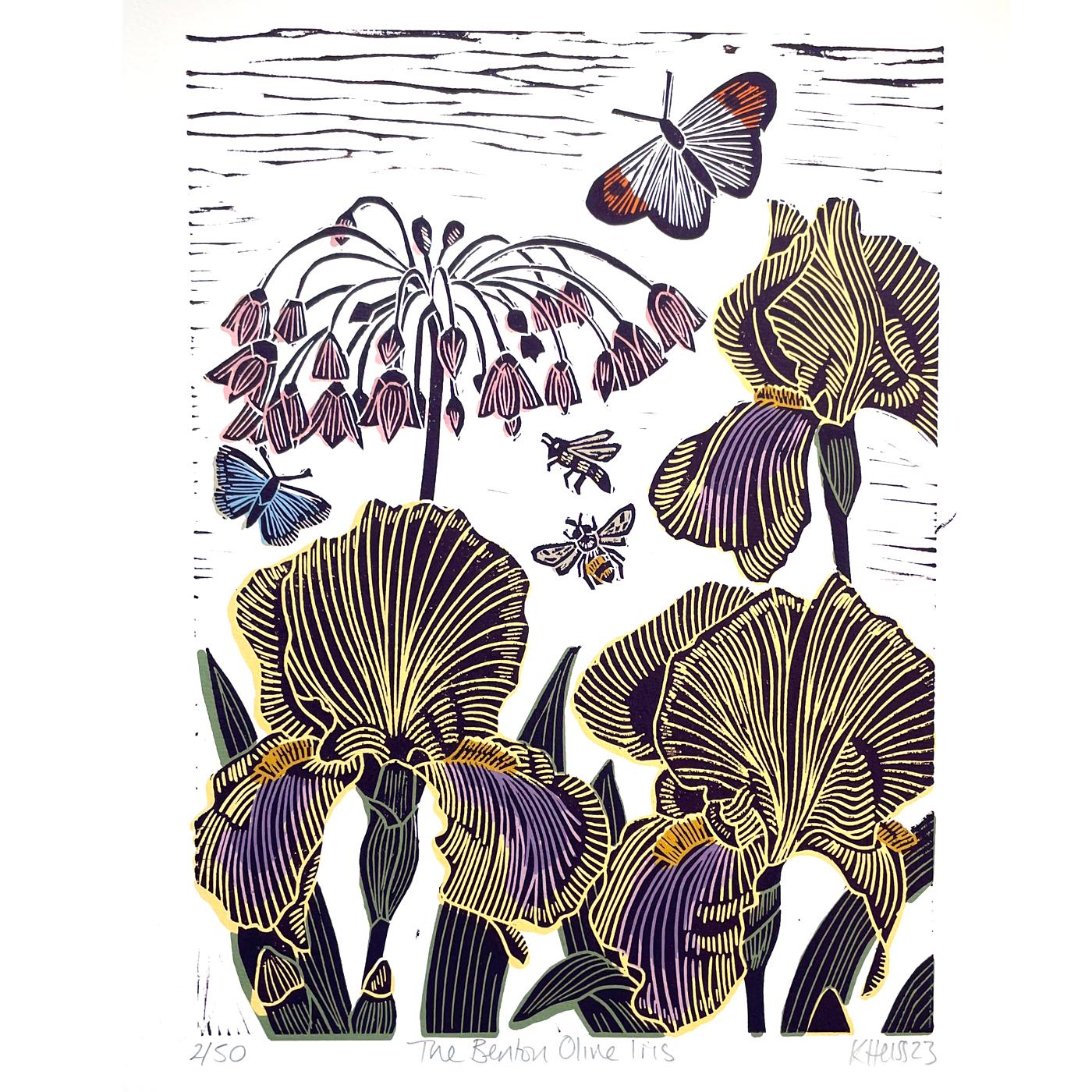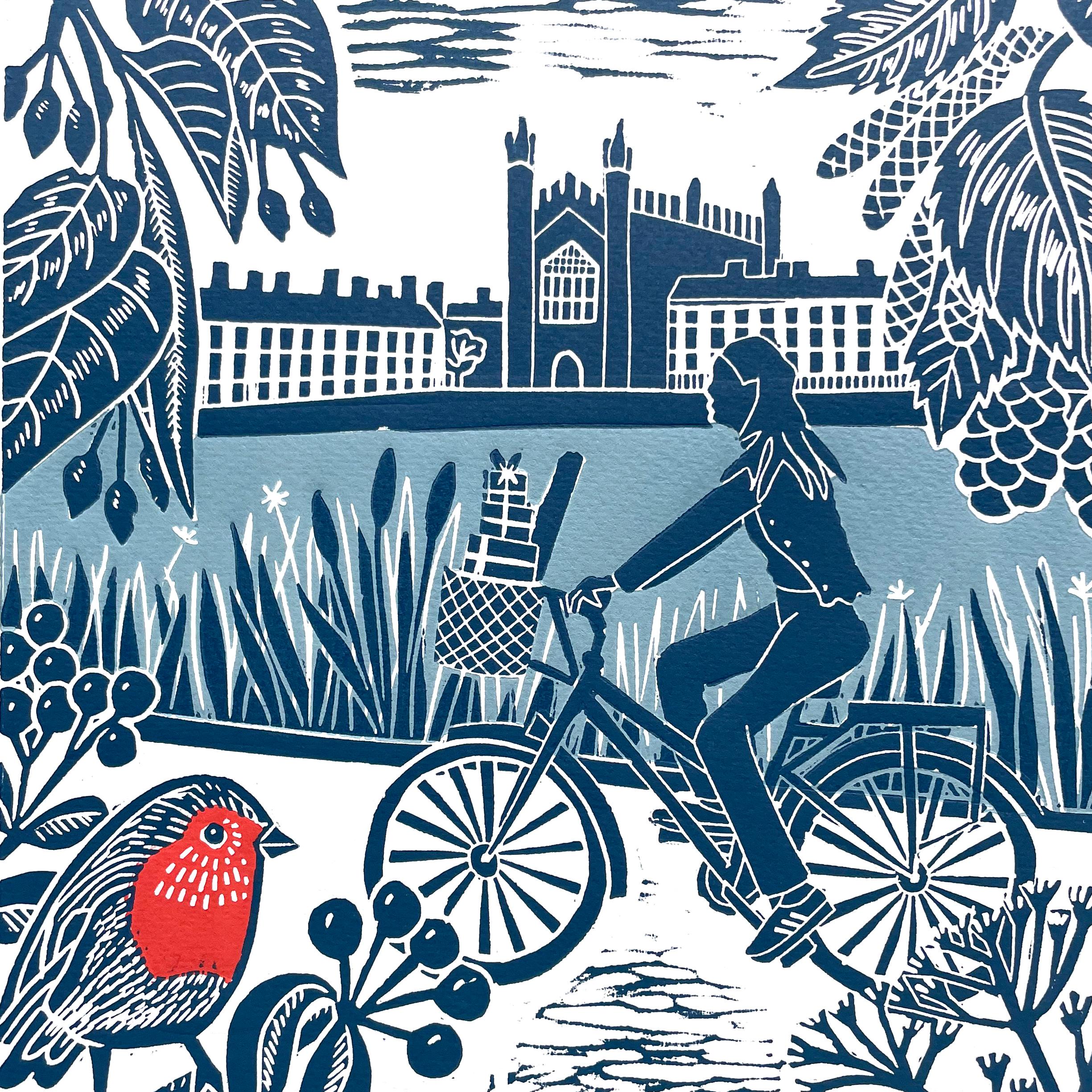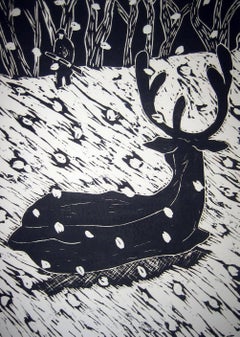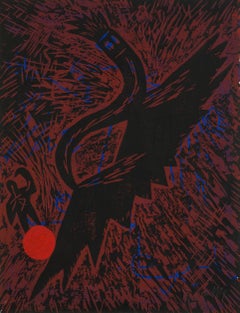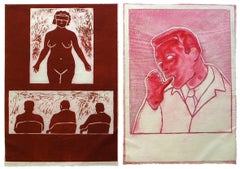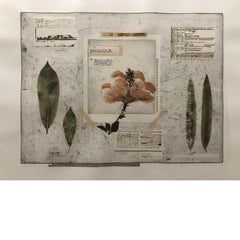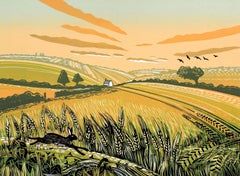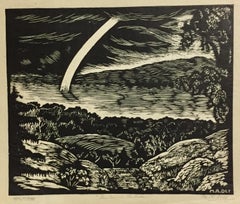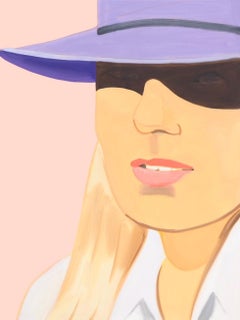Items Similar to Untitled (Poison)
Want more images or videos?
Request additional images or videos from the seller
1 of 5
Richard BosmanUntitled (Poison)1982
1982
About the Item
Richard Bosman (b. 1944) is a painter and printmaker known for his woodcuts depicting turbulent seascapes. He studied at Bryam Shaw School of Painting and Drawing in London, The New York Studio School, and the Skowhegan School of Painting and Sculpture in Maine. In the early 1980s, Bosman heralded the return of representation with dramatic paintings that recalled the drama and dark romance of sensationalist crime photography and pulp fiction. Later in his career, he moved away from manmade drama, opting to depict instead the natural phenomena of volcanoes, ebbing tides, and crashing waves. Bosman is the recipient of a Guggenheim Fellowship. His work has been exhibited extensively, including solo shows at numerous international galleries, as well as in group exhibitions at museum venues including the Museum of Modern Art, the Walker Art Center, the Whitney Museum, and the Brooklyn Museum. His work also is in the collection of numerous museums including the Detroit Institute of Arts, The Fogg Art Museum at Harvard University, the Metropolitan Museum of Art in New York, the Museum of Modern Art in New York, the National Museum of American Art and the Library of Congress, both in Washington, D.C., the Museum of Contemporary Art in Los Angeles, the Philadelphia Museum of Art, the Walker Art Center, the Whitney Museum of American Art, and many others.
- Creator:Richard Bosman (1944, American)
- Creation Year:1982
- Dimensions:Height: 18 in (45.72 cm)Width: 12 in (30.48 cm)
- More Editions & Sizes:Ed. 50Price: $1,500
- Medium:
- Period:
- Condition:
- Gallery Location:New York, NY
- Reference Number:1stDibs: LU329210322662
Richard Bosman
Richard Bosman (b. 1944) is a painter and printmaker known for his woodcuts depicting turbulent seascapes. He studied at Bryam Shaw School of Painting and Drawing in London, The New York Studio School, and the Skowhegan School of Painting and Sculpture in Maine. In the early 1980s, Bosman heralded the return of representation with dramatic paintings that recalled the drama and dark romance of sensationalist crime photography and pulp fiction. Later in his career, he moved away from manmade drama, opting to depict instead the natural phenomena of volcanoes, ebbing tides, and crashing waves. Bosman is the recipient of a Guggenheim Fellowship. His work has been exhibited extensively, including solo shows at numerous international galleries, as well as in group exhibitions at museum venues including the Museum of Modern Art, the Walker Art Center, the Whitney Museum, and the Brooklyn Museum. His work also is in the collection of numerous museums including the Detroit Institute of Arts, The Fogg Art Museum at Harvard University, the Metropolitan Museum of Art in New York, the Museum of Modern Art in New York, the National Museum of American Art and the Library of Congress, both in Washington, D.C., the Museum of Contemporary Art in Los Angeles, the Philadelphia Museum of Art, the Walker Art Center, the Whitney Museum of American Art, and many others
About the Seller
5.0
Recognized Seller
These prestigious sellers are industry leaders and represent the highest echelon for item quality and design.
Established in 1979
1stDibs seller since 2015
67 sales on 1stDibs
Typical response time: 2 hours
Associations
International Fine Print Dealers Association
- ShippingRetrieving quote...Shipping from: New York, NY
- Return Policy
Authenticity Guarantee
In the unlikely event there’s an issue with an item’s authenticity, contact us within 1 year for a full refund. DetailsMoney-Back Guarantee
If your item is not as described, is damaged in transit, or does not arrive, contact us within 7 days for a full refund. Details24-Hour Cancellation
You have a 24-hour grace period in which to reconsider your purchase, with no questions asked.Vetted Professional Sellers
Our world-class sellers must adhere to strict standards for service and quality, maintaining the integrity of our listings.Price-Match Guarantee
If you find that a seller listed the same item for a lower price elsewhere, we’ll match it.Trusted Global Delivery
Our best-in-class carrier network provides specialized shipping options worldwide, including custom delivery.More From This Seller
View AllConfrontation
By Richard Bosman
Located in New York, NY
Richard Bosman is a painter and printmaker known for his woodcuts depicting turbulent seascapes. He studied at Bryam Shaw School of Painting and Drawing in London, The New York Studi...
Category
20th Century Contemporary Figurative Prints
Materials
Linocut
Untitled
Located in New York, NY
Linocut in colors on wove paper, signed and dated in pencil lower right and numbered 'III 50/50' on the verso, published by Maximilian Verlag/Sabine Knust, Munich, the full sheet, fr...
Category
1980s Expressionist Animal Prints
Materials
Linocut
$720 Sale Price
20% Off
American Medical Association II
By Ida Applebroog
Located in New York, NY
Born in Bronx, NY, Ida Applebroog attended NY State Institute of Applied Arts and Sciences (1949). She moved to Chicago in 1956,later attending the School of the Art Institute of Chi...
Category
Late 20th Century Contemporary Figurative Prints
Materials
Linocut
$8,000 Sale Price
20% Off
Voyage to the South Seas: Flora Otaheite
By Michelle Stuart
Located in New York, NY
Michelle Stuart is an American artist whose work references a range of influences, from history to astronomy and botany, as well as her extensive travels to ancient archaeological si...
Category
1990s Prints and Multiples
Materials
Etching, Aquatint
Hegel's Cellar Portfolio
By John Baldessari
Located in New York, NY
It is hard to characterize John Baldessari’s varied practice—which includes photomontage, artist’s books, prints, paintings, film, performance, and installation—except through his ap...
Category
1980s Conceptual Prints and Multiples
Materials
Etching
Price Upon Request
Second Quartet: Black and White, State II
By Mel Bochner
Located in New York, NY
Signed and dated on verso.
Mel Bochner is recognized as one of the leading figures in the development of Conceptual art in New York in the 1960s and 1970s. Emerging at a time when p...
Category
Late 20th Century Conceptual More Prints
Materials
Lithograph
You May Also Like
Running Through The Barley, Limited edition art print, Landscape, Nature, Fields
By Rob Barnes
Located in Deddington, GB
The first crop to ripen is usually the barley. Hares can be seen running through it as it gives good cover for them. You need a keen eye to see these fast creatures, but a glance at ...
Category
2010s Contemporary Landscape Prints
Materials
Linocut, Paper
Maurice Robert Dey, Rainbow on the Hudson
Located in New York, NY
Biographical information on Maurice Robert Dey is hard to find. He was born on 1899 (or maybe 1900), in Switzerland. As an adult he lived and worked in Woodstock, the NY artists' c...
Category
1930s American Modern Landscape Prints
Materials
Linocut
Nicole (12/12)
By Alex Katz
Located in Fort Lauderdale, FL
Alex Katz was born in Brooklyn, New York in 1927. In 1928, at the outset of the Depression, his family moved to St. Albans, a diverse suburb of Queens that had sprung up between the two wars. Katz was raised in St. Albans by his Russian parents. His mother had been an actress and possessed a deep interest in poetry and his father, a businessman, also had an interest in the arts. Katz attended Woodrow Wilson High School for its unique program that allowed him to devote his mornings to academics and his afternoons to the arts. In 1946, Katz entered The Cooper Union Art School in Manhattan, a prestigious college of art, architecture, and engineering. At The Cooper Union, Katz studied painting under Morris Kantor and was trained in Modern art theories and techniques. Upon graduating in 1949, Katz was awarded a scholarship for summer study at the Skowhegan School for Painting and Sculpture in Maine, a grant that he would renew the following summer.
During his years at Cooper Union, Katz had been exposed primarily to modern art and was taught to paint from drawings. Skowhegan exposed him to painting from life, which would prove pivotal in his development as a painter and remains a staple of his practices today. Katz explains that Skowhegan’s plein air painting gave him “a reason to devote my life to painting.” Katz’s first one-person show was held at the Roko Gallery in 1954. Katz had begun to develop greater acquaintances with the New York School and their allies in the other arts; he counted amongst his friends’ figurative painters Larry Rivers and Fairfield Porter, photographer Rudolph Burckhardt, and poets John Ashbery, Edwin Denby, Frank O’Hara, and James Schuyler. From 1955 to 1959, usually following a day of painting, Katz made small collages of figures in landscapes from hand-colored strips of delicately cut paper.
In the late 1950s, he moved towards greater realism in his paintings. Katz became increasingly interested in portraiture, and painted his friends and his wife and muse, Ada. He embraced monochrome backgrounds, which would become a defining characteristic of his style, anticipating Pop Art and separating him from gestural figure painters and the New Perceptual Realism. In 1959, Katz made his first cutout, which would grow into a series of flat “sculptures;” freestanding or relief portraits that exist in actual space.
In the early 1960s, influenced by films, television, and billboard advertising, Katz began painting large-scale paintings, often with dramatically cropped faces. In 1965, he also embarked on a prolific career in printmaking. Katz would go on to produce many editions in lithography, etching, silkscreen, woodcut and linoleum cut. After 1964, Katz increasingly portrayed groups of figures.
He would continue painting these complex groups into the 1970s, portraying the social world of painters, poets, critics, and other colleagues that surrounded him. He began designing sets and costumes for choreographer Paul Taylor in the early 1960s, and he has painted many images of dancers throughout the years. In the 1980s, Katz took on a new subject in his work: fashion models in designer clothing. In the late 1980s and 1990s, Katz focused much of his attention on large landscape paintings, which he characterizes as “environmental.” Rather than observing a scene from afar, the viewer feels enveloped by nearby nature. Katz began each of these canvases with “an idea of the landscape, a conception,” trying to find the image in nature afterwards. In his landscape paintings, Katz loosened the edges of the forms, executing the works with greater painterliness than before in these allover canvases. In 1986, Katz began painting a series of night pictures—a sharp departure from the sunlit landscapes he had previously painted, forcing him to explore a new type of light. Variations on the theme of light falling through branches appear in Katz’s work throughout the 1990s and into the 21st century.
At the beginning of the new millennium, Katz also began painting flowers in profusion, covering canvases in blossoms similar to those he had first explored in the late 1960s, when he painted large close-ups of flowers in solitude or in small clusters. More recently Katz began painting a series of dancers and one of nudes, which was the subject of a 2011 exhibition at the Kestnergesellschaft in Hanover. Katz’s work continues to grow and evolve today. Alex Katz's work has been the subject of more than 200 solo exhibitions and nearly 500 group exhibitions internationally since 1951. In 2010, Alex Katz Prints was on view at the Albertina Museum in Vienna, which showed a retrospective survey of over 150 graphic works from a recent donation to the museum by Katz of his complete graphic oeuvre. The National Portrait Gallery in London presented an exhibition titled Alex Katz Portraits.
In June 2010, The Farnsworth Art Museum in Rockland, Maine opened Alex Katz: New Work, exhibiting recent large-scale paintings inspired by his summers spent in Maine. Katz was also represented in a show at the Metropolitan Museum of Art, New York, curated by Marla Prather, entitled Facing the Figure: Selections from the Permanent Collection, 2010. In 2009-2010, Alex Katz: An American Way Of Seeing was on view at the Sara Hildén Art Museum, Tampere, Finland; Musée Grenoble, Grenoble, France; and the Museum Kurhaus Kleve, Kleve, Germany. In 2007, Alex Katz: New York opened at the Irish Museum of Modern Art, Dublin, Ireland. The show, which included approximately 40 paintings and aquatints, was the first exhibition to concentrate primarily on Katz’s relationship with his native city.
The Jewish Museum, New York, presented Alex Katz Paints Ada in 2006-2007, an exhibition of 40 paintings focused on Katz’s wife, Ada, dating from 1957 to 2005. It coincided with an exhibition devoted to Katz’s paintings of the 1960s at PaceWildenstein, Alex Katz: The Sixties, on view from April 27 through June 17, 2006 at 545 West 22nd Street. Alex Katz in Maine, an exhibition of landscapes and portraits made over six decades, opened at The Farnsworth Art Museum and Wyeth...
Category
2010s Contemporary Prints and Multiples
Materials
Linocut
Price Upon Request
Sunrise 1
By Alex Katz
Located in Fort Lauderdale, FL
Alex Katz was born in Brooklyn, New York in 1927. In 1928, at the outset of the Depression, his family moved to St. Albans, a diverse suburb of Queens that had sprung up between the two wars. Katz was raised in St. Albans by his Russian parents. His mother had been an actress and possessed a deep interest in poetry and his father, a businessman, also had an interest in the arts. Katz attended Woodrow Wilson High School for its unique program that allowed him to devote his mornings to academics and his afternoons to the arts. In 1946, Katz entered The Cooper Union Art School in Manhattan, a prestigious college of art, architecture, and engineering. At The Cooper Union, Katz studied painting under Morris Kantor and was trained in Modern art theories and techniques. Upon graduating in 1949, Katz was awarded a scholarship for summer study at the Skowhegan School for Painting and Sculpture in Maine, a grant that he would renew the following summer.
During his years at Cooper Union, Katz had been exposed primarily to modern art and was taught to paint from drawings. Skowhegan exposed him to painting from life, which would prove pivotal in his development as a painter and remains a staple of his practices today. Katz explains that Skowhegan’s plein air painting gave him “a reason to devote my life to painting.” Katz’s first one-person show was held at the Roko Gallery in 1954. Katz had begun to develop greater acquaintances with the New York School and their allies in the other arts; he counted amongst his friends’ figurative painters Larry Rivers and Fairfield Porter, photographer Rudolph Burckhardt, and poets John Ashbery, Edwin Denby, Frank O’Hara, and James Schuyler. From 1955 to 1959, usually following a day of painting, Katz made small collages of figures in landscapes from hand-colored strips of delicately cut paper.
In the late 1950s, he moved towards greater realism in his paintings. Katz became increasingly interested in portraiture, and painted his friends and his wife and muse, Ada. He embraced monochrome backgrounds, which would become a defining characteristic of his style, anticipating Pop Art and separating him from gestural figure painters and the New Perceptual Realism. In 1959, Katz made his first cutout, which would grow into a series of flat “sculptures;” freestanding or relief portraits that exist in actual space.
In the early 1960s, influenced by films, television, and billboard advertising, Katz began painting large-scale paintings, often with dramatically cropped faces. In 1965, he also embarked on a prolific career in printmaking. Katz would go on to produce many editions in lithography, etching, silkscreen, woodcut and linoleum cut. After 1964, Katz increasingly portrayed groups of figures.
He would continue painting these complex groups into the 1970s, portraying the social world of painters, poets, critics, and other colleagues that surrounded him. He began designing sets and costumes for choreographer Paul Taylor in the early 1960s, and he has painted many images of dancers throughout the years. In the 1980s, Katz took on a new subject in his work: fashion models in designer clothing. In the late 1980s and 1990s, Katz focused much of his attention on large landscape paintings, which he characterizes as “environmental.” Rather than observing a scene from afar, the viewer feels enveloped by nearby nature. Katz began each of these canvases with “an idea of the landscape, a conception,” trying to find the image in nature afterwards. In his landscape paintings, Katz loosened the edges of the forms, executing the works with greater painterliness than before in these allover canvases. In 1986, Katz began painting a series of night pictures—a sharp departure from the sunlit landscapes he had previously painted, forcing him to explore a new type of light. Variations on the theme of light falling through branches appear in Katz’s work throughout the 1990s and into the 21st century.
At the beginning of the new millennium, Katz also began painting flowers in profusion, covering canvases in blossoms similar to those he had first explored in the late 1960s, when he painted large close-ups of flowers in solitude or in small clusters. More recently Katz began painting a series of dancers and one of nudes, which was the subject of a 2011 exhibition at the Kestnergesellschaft in Hanover. Katz’s work continues to grow and evolve today. Alex Katz's work has been the subject of more than 200 solo exhibitions and nearly 500 group exhibitions internationally since 1951. In 2010, Alex Katz Prints was on view at the Albertina Museum in Vienna, which showed a retrospective survey of over 150 graphic works from a recent donation to the museum by Katz of his complete graphic oeuvre. The National Portrait Gallery in London presented an exhibition titled Alex Katz Portraits.
In June 2010, The Farnsworth Art Museum in Rockland, Maine opened Alex Katz: New Work, exhibiting recent large-scale paintings inspired by his summers spent in Maine. Katz was also represented in a show at the Metropolitan Museum of Art, New York, curated by Marla Prather, entitled Facing the Figure: Selections from the Permanent Collection, 2010. In 2009-2010, Alex Katz: An American Way Of Seeing was on view at the Sara Hildén Art Museum, Tampere, Finland; Musée Grenoble, Grenoble, France; and the Museum Kurhaus Kleve, Kleve, Germany. In 2007, Alex Katz: New York opened at the Irish Museum of Modern Art, Dublin, Ireland. The show, which included approximately 40 paintings and aquatints, was the first exhibition to concentrate primarily on Katz’s relationship with his native city.
The Jewish Museum, New York, presented Alex Katz Paints Ada in 2006-2007, an exhibition of 40 paintings focused on Katz’s wife, Ada, dating from 1957 to 2005. It coincided with an exhibition devoted to Katz’s paintings of the 1960s at PaceWildenstein, Alex Katz: The Sixties, on view from April 27 through June 17, 2006 at 545 West 22nd Street. Alex Katz in Maine, an exhibition of landscapes and portraits made over six decades, opened at The Farnsworth Art Museum and Wyeth...
Category
2010s Contemporary Prints and Multiples
Materials
Linocut
Price Upon Request
Benton Olive Iris, Limited edition print, Nature, Floral
By Kate Heiss
Located in Deddington, GB
This print features a cloud of insects attracted to the Alium siculum and Benton Olive irises. This print was inspired by the beautiful Nurture Garden by Sarah Price at RHS Chelsea 2...
Category
2010s Contemporary Landscape Prints
Materials
Linocut
Cambridge Life, Limited edition print, Nature, Cityscape
By Kate Heiss
Located in Deddington, GB
This is a handmade Linocut relief print of a cyclist riding along the Backs of Cambridge with Kings College Chapel in the distance and a robin in the foreground. It is a limited edit...
Category
2010s Contemporary Landscape Prints
Materials
Linocut
Recently Viewed
View AllMore Ways To Browse
Untitled Offset
Victor Vasarely 1970
Vintage British Railways Poster
Village De Provence
Vintage Devil Art
Two Large Stained Glass Windows
Victor Vasarely Geometric Abstract Art
Venice Silk
Villa Borghese
Vintage Comic Strip
Venice Picture Frame
Vintage Cardinals
Van Gogh Cat
Venet Bernar
Vintage Bookmarks
Vintage Americana Signs
Views Of Rome Engraving
Views Of Rome Engravings
